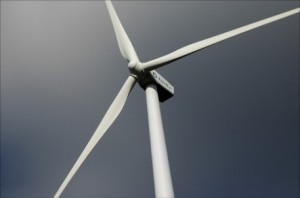If you are interested in learning what wind turbines are, you’ve come to the right place. In a few words, wind turbines are elegant devices with blades or sails that are used to harness clean energy from the wind. They do not burn fuel or create pollutants, but it is possible that we will someday be able to harness enough power from wind energy that we no longer have to use toxic energy sources to maintain our standards of living.
When people talk about wind turbines — sometimes called wind chargers or wind generators — they are usually referring to the wind turbines commonly used en masse for supplying electric power to a region. Sometimes the term is used to talk about windmills, which are technically a kind of wind turbine though their purposes vary. While a windmill could potentially mill grain or pump water, one that is dubbed a “wind turbine” usually generates electricity for a small area.
A collection of electricity-producing wind turbines is called a wind farm. Wind farms can be placed in any open space where there is enough wind, including open hilltops and in the sand or water along ocean shorelines. There are wind farms on each of the 6 inhabited continents. Not only do they provide sustainable clean power for the towns and cities they are nearby, but they also add an interesting aesthetic to the landscape.
What are the types of wind turbines?
The two main types of wind turbines are horizontal-axis wind turbines (HAWT) and vertical-axis wind turbines (VAWT). Their names come from the orientation of their rotor shafts. Appropriately, a HAWT’s rotor shaft is arranged horizontally, while a VAWT’s is arranged vertically. HAWTs must face into the wind to be effective, so they require a mechanism such as wind vane or an electric sensor to keep them properly aligned. VAWTs catch the wind regardless of the direction it is blowing.
While HAWTs have been used in many cultures through the centuries, their design has by and large stayed the same. VAWTs are particularly interesting in their recent technological advancements and in their design sub-types. Because VAWTs do not need to be as tall as HAWTs to catch wind, they are easier to maintain than HAWTs. They may also be able to be spaced closer together than their HAWT counterparts if they are placed in complimentary patterns. One drawback of using VAWT instead of HAWT, is that each unit doesn’t produce quite as much energy as a HAWT would.
What’s next for wind turbines?
In recent decades, technological advancements have made using wind power easier and cheaper than ever. Large-scale projects that could generate enough power for the entire human race may not be such a far off notion. Communities have the power to create their own clean energy in what may become a second age of wind turbines. The possibilities even trickle down to individuals. It is actually possible to create our own wind turbines for home use or small scale recreation use. In fact, the next time you are out on a boat, you could use a small wind turbine to power your mini-fridge.
Back to Vertical Wind Turbine main page.


Comments are closed